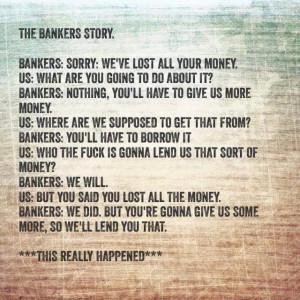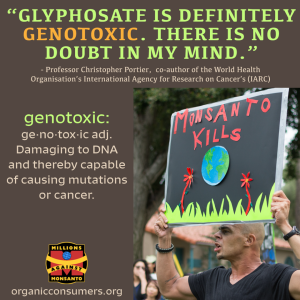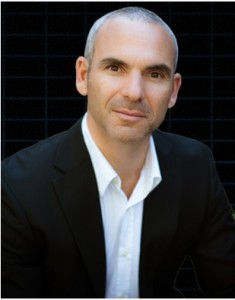
We can turn you into a zombie too! That way you won’t feel anything!
The Bankers Story
Natural vs. Synthetic Vitamin C
I have had two people tell me recently that they have heard that Ascobic Acid (that I use in my food bars and powders) is not as good as natural sources of vitamin C. While I agree with “natural is better than synthetic” as a principle and have seen claims, assertations and opinions to that effect but the below is the only reference I have seen to studies testing the hypothesis. If you come across any clinical studies, please let me know.
Natural and synthetic L-ascorbic acid are chemically identical, and there are no known differences in their biological activity. The possibility that the bioavailability of L-ascorbic acid from natural sources might differ from that of synthetic ascorbic acid was investigated in at least two human studies, and no clinically significant differences were observed. A study of 12 males (6 smokers and 6 nonsmokers) found the bioavailability of synthetic ascorbic acid (powder administered in water) to be slightly superior to that of orange juice, based on blood levels of ascorbic acid, and not different based on ascorbic acid in leukocytes (white blood cells) (1). A study in 68 male nonsmokers found that ascorbic acid consumed in cooked broccoli, orange juice, orange slices, and as synthetic ascorbic acid tablets are equally bioavailable, as measured by plasma ascorbic acid levels (2, 3).
http://lpi.oregonstate.edu/mic/vitamins/vitamin-C/supplemental-forms
Understanding and Handling Leaky Gut Syndrome
Leaky Gut Syndrome (LGS) is the root of many of our contemporary health issues. In fact, some sources claim that LGS is the underlying cause of up to 50% of chronic medical complaints.
http://foodmatters.tv/content/understanding-leaky-gut-syndrome
Dr. Mary's Monkey: How the Unsolved Murder of a Doctor, a Secret Laboratory in New Orleans and Cancer-Causing Monkey Viruses Are Linked to Lee Harvey … Assassination and Emerging Global Epidemics
This new updated edition is not only hard cover for long life, but it contains an additional 25 pages of revelations from the author including documents from the FBI, CIA, CDC, and NOPD, plus the actual crime scene photos of the Mary Sherman murder. You’ll see why we say this is the “Hottest cold case in America.” The 1964 murder of a nationally known cancer researcher sets the stage for this gripping exposé of medical professionals enmeshed in covert government operations over the course of three decades. Following a trail of police records, FBI files, cancer statistics, and medical journals, this revealing book presents evidence of a web of medical secret-keeping that began with the handling of evidence in the JFK assassination and continued apace, sweeping doctors into cover-ups of cancer outbreaks, contaminated polio vaccine, the arrival of the AIDS virus, and biological weapon research using infected monkeys.
http://www.amazon.com/Dr-Marys-Monkey-Cancer-Causing-Assassination/dp/1937584593
In the US You Cannot Sue A Drug Company for Death or Disability Caused by Vaccines
Ever wonder why?
Also, here’s some very interesting info on how Big Pharma got this immunity in the first place (excerpted from an article from the National Vaccine Infomation Center, original publishing by Barbara Fisherone):
Big Pharma Blackmailed Congress in 1982
To understand how this happened, we have to turn the clock back to 1982. That is when four big drug companies (Merck, Wyeth, Lederle, Connaught) blackmailed Congress by threatening to stop selling vaccines in America unless a law was passed giving them complete immunity from prosecution.
The pharmaceutical industry knew they were in big trouble because the old, crude whooping cough vaccine in the DPT shot was causing brain inflammation and death in many children; the live oral polio vaccine was crippling children and adults with vaccine strain polio; and Americans were filing lawsuits to hold drug companies responsible for the safety of their products.
Supreme Court Allows Seat Belt Injury Lawsuits
On February 23, 2011, one day after the Supreme Court blocked lawsuits against drug companies for failing to make vaccines safer, they cleared the way for lawsuits against car manufacturers for failing to make seat belts safer.
Civil Liability Is A Consumer Protection
Civil liability is a consumer protection. In the past, civil liability has protected us from wealthy tobacco corporations selling cigarettes that were once endorsed by doctors and the U.S. government. Civil liability has protected us from defective cars and toys and food and drugs that have passed federal licensing and safety standards.
Civil liability put pressure on drug companies to develop and license a less toxic pertussis vaccine in 1996. Civil liability put pressure on federal health agencies to replace use of a contaminated, neurotoxic polio vaccine that can paralyze people with one that cannot. Parents in 1980’s Opposed Total Liability Shield
Thirty years ago the wealthiest and most powerful industry lobbying on Capitol Hill and in state legislatures – the multi-billion dollar pharmaceutical industry – tried very hard to get total liability protection for every vaccine that government regulates, recommends and mandates.
The only difference is that three decades ago, government officials were ordering doctors to give children 23 doses of 7 vaccines and, today, that direct order is up to 70 doses of 16 vaccines.
The parent co-founders of the National Vaccine Information Center worked with Congress back in the early 1980’s and we refused to support any legislation that would legally let the pharmaceutical industry completely off the hook.
Vaccines Are Phamaceutical Products
Vaccines are pharmaceutical products that carry a risk of injury or death, a risk that can be greater for some than others. If a vaccine is effective, then those choosing to use that vaccine will have nothing to fear from those who make another health care choice. If a vaccine is not effective, then consumers are being asked to take two risks: a risk they will be harmed and a risk the vaccine will not work at all.
That is not a product that should be legally required, especially when doctors cannot predict ahead of time who will be harmed by a vaccine and there is no civil liability for the company selling it, the person giving it or the government official mandating it.
No liability?
No accountability?
No mandates.
Taken from National Vaccine Infomation Center, original publishing by Barbara Fisher
THE HEART’S INTUITIVE INTELLIGENCE: SCIENTIFIC PROOF OF INTUITION
They are close but have have either not yet learned that what they are measuring is the being and its vibration and other qualities, not the heart muscle, or are deliberately making the message more acceptable by slightly altering the source from the spiritual to the physical.
You are a spiritual being with the potential to know everything, past, present and future.
Some experience moments of increased awareness.
Some have abilities others do not choose yet to manifest.
The core message is sound – that you as a being have a vibration that can be sensed and measured by others. By eschewing those individuals who and those activities and thoughts that lower our vibration rate and associating more with those people at or above our own vibration rate and engaging in activities and thoughts that raise our vibration we raise our survival potential and that of those around us.
http://thespiritscience.net/2015/07/02/the-hearts-intuitive-intelligence-scientific-proof-of-intuition/
Who Will Bail Out Humanity If the GMO Evangelists Win?
Here’s the text of the article. It has many reference links in the original post to which I link at the foot of my reproduction.
by Colin Todhunter July 17, 2015
The pro-GMO lobby likes to think it has the monopoly on truth. Anyone questioning its creed is attacked and smeared. GM Supporters claim to be big on science and peer review. While mouthing slogans about science and its pivotal role in steering the GM debate, they rely on unscientific tactics and polemics to promote their cause. They censor and distort scientific research and attack and smear scientists and others who criticise the pro-GMO establishment and the efficacy of or need for this technology. They also forward bogus claims based on the (inept – see this) studies they cite (see this, this and this to read about the points made here).
Rather than let science and rational discussion underpin the debate and attempt to use that to convince decision makers, the GM industry relies on expensive lobbying campaigns to attack transparency, resorts to fakery, bribery, intimidation, dirty tricks and the corrupting of public sector bodies that in principle exist to uphold the public interest.
The fact remains that, in spite of these tactics and the funds at its disposal, the pro-GMO lobby has to date failed to make much headway in getting this technology accepted in most countries across the world. It has failed to make a convincing case for the need for GM, and its tactics have been shoddy and its reasoning bogus.
It says its opponents are anti-science who are bucking the supposed scientific consensus on GM and are preventing progress while overstating the risks involved. These claims have already been exposed as fallacious, but a recent piece in the New York Times by an investment expert and a prominent scientific advisor with an interest in risk management provides some revealing insight. They deconstruct the myths that the industry relies on to promote GMOs and draw parallels with the financial collapse that led to the current ongoing economic crisis.
Mark Spitznagel and Professor Nassim Taleb argue that prior to the economic crisis that started in 2007, they believed that the financial system was fragile and unsustainable, contrary to the near ubiquitous analyses at the time. Most people held that the financial system could not fail because it was underpinned by expert analyses and the latest technology, leading to greater sophisticated economic insight.
However, Spitznagel and Taleb perceived the effect from rare but consequential events had been increasing and almost no one was paying attention to the greater risks involved due to the increasing complexity of the system. As the money rolled in and the rich got richer, people were ignoring or downplaying the risks.
At the time, the two authors were attacked for being ‘against science’. Their adversaries invoked consensus among economists in favour of the prevailing methods. They also encountered the belief that ‘more technology is invariably better’. They were told that had ideas such as theirs prevailed in the past, they would have hindered risk-taking. Moreover, toxic financial exposures were deemed to be ‘safe’, according to primitive risk models.
Spitznagel and Taleb also noted that the financial system kept relying on ‘predictions’, not noticing that the past track record of predictions by central bankers and economists had often been way off the mark. The entire economic system rested on these flimsy predictions.
They were repeatedly told that there was evidence that the system was stable, based on the notion that mistakes absence of evidence for evidence of absence, but they argued that for the financial system to be viable, the solution is for it to resemble the restaurant business: decentralised, with mistakes that stay local and that cannot bring down the entire apparatus.
Similar agruments and attacks on its critics are forwarded by the pro-GMO lobby. There is a tendency to label anyone who opposes GM as anti-science and Luddite, not least because they are arguing against a supposed ‘scientific consensus’. This so-called ‘consensus’ is nothing but a fiction of the collective imagination of the pro-GMO lobby. At any rate, had science operated solely by consensus, Spitznagel and Taleb argue that we would still be stuck in the Middle Ages: scientific consensus is used in telling us what theory is wrong but cannot determine what is right; nor can it apply to risk management, they argue, which requires much greater scrutiny.
They go on to state that most technologies fail in the long run, and the first rule of risk-taking is to not cross the street blindfolded – which is what the GMO lobby would like us all to do given that there are flaws and serious risks (see this and this) associated with this technology and that the arguments promoting it are bogus. Furthermore, the processes involved in getting it onto the commercial market were fraudulent, and there has not been a single independent long-term epidemiological study on GMOs.
Spitznagel and Taleb state that the ‘technological salvation’ argument they faced in finance is also present with GMOs: that this technology is needed to ‘feed the world’ or to ‘save dying children’ with GM fortified rice (when an argument cannot be won, the pro-GMO lobby resorts to emotional blackmail).
They assert that the premise behind GM rice is flawed because, in a complex system, we do not know the causal chain and it is better to solve a problem by the simplest method, not least one that is unlikely to cause a bigger problem. (Note: The arguments in favour of Golden Rice are flawed on various levels and could indeed lead to greater problems: see this and this.)
In a more general sense, Spitznagel and Taleb see the same trend with GM as they saw in the globalised financial system: all risks are systemic and affect the entire population and ecosystem. The risks associated with GMOs are more severe than those of finance, however. The impact can result in complex and unpredictable changes in human health and the environment, while the methods of risk management – unlike finance, where some effort was made – are less than primitive.
Once the food system is contaminated by GMOs, there may be no going back. The GMO industry is carrying out a massive unscientific (despite what it would like us to believe) experiment using people as human guinea pigs to rake in massive profits. Fuelled by the same profit motive (poorly hidden behind the mask of humanitarian intent), those behind the GM project are just as (even more) arrogant and reckless as were (and are) their deregulating neoliberal evangelist bedfellows in the finance sector.
Given the political connections of the GM industry and the active support it is receiving from governments and institutions across the world, it is being propped up regardless of its impacts on health, the environment and the livelihoods of small farmers – who already feed most of the world, despite the marginalisation they experience.
The pro-GMO lobby tries to focus the debate on ‘the science’ surrounding this technology because once the argument is broadened to include the politics of GM and the wider social implications and impacts, the discussion takes it onto ground that it is unable or unwilling to engage on (for example, see this, this and this). But even when confining ourselves to the science of GM, its supporters still fail to provide a convincing case for GM.
Just like with the mega banks and the swindlers behind them, we are witnessing another systemic and politically well-connected, corrupt enterprise that is ‘too big to fail’. Spitznagel and Taleb are right to ask: who will be there to bail out humanity once it does fail?
Colin Todhunter is an extensively published independent writer and former social policy researcher based in the UK and India.
http://www.counterpunch.org/2015/07/17/who-will-bail-out-humanity-if-the-gmo-evangelists-win/



